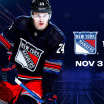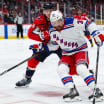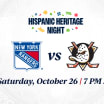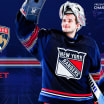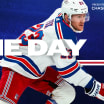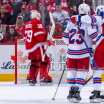SPECIAL TICKET PACKAGE: Join us on 12/2 for an exclusive pre-game meet & greet featuring the GAG Line and then witness Rangers history when Vic Hadfield's #11 is raised to the rafters at The Garden. CLICK HERE TO GET TICKETS »
Vic Hadfield describes himself this way: "I am a Ranger through and through."
He was the captain of the Rangers in the 1970s, the first 50-goal scorer in the history of the franchise, the ultimate teammate - and on Dec. 2, his No. 11 will take its place among the Rangers legends in the Garden rafters.
NYRangers.com will present 11 of the great moments of Hadfield's career, 11 snapshots of the Blueshirts' legendary left winger, 11 for No. 11 - counting down to the celebration of Vic Hadfield Night presented by Budweiser before the Blueshirts take on the Winnipeg Jets on Dec. 2 at Madison Square Garden.
Part of the legend of Vic Hadfield's career is the evolution of it, how the Rangers winger went from among the perennial League leaders in penalty minutes to among the League's better goal scorers. There are obvious reasons to point to, not least the introduction of Hadfield onto a line with Rod Gilbert and Jean Ratelle. "I have to say we had something to do with it," Gilbert said.
But less conspicuously, there was one other Hall of Famer in the mix, one who never scored a goal for the Rangers but who, in a case of right place, right time, had a hand in forming Vic Hadfield into the scorer that he became.
The precise date may remain a mystery, but the setting and the cast of characters are well known to hockey fans. The Rangers were in Chicago for a game probably sometime in 1966 or '67; Hadfield recalls that at the old Chicago Stadium, the player entrances to the building were positioned such that Black Hawks players had to walk past the visiting team on their way to the home dressing room.
And so it was that Hadfield found himself milling around outside the Rangers' room, when Bobby Hull came walking by.
"I just happened to be out in the hallway and here comes Bobby. So I said to Bobby, 'Hey Bobby, I'm short of sticks. Have you got three spares over there that I could try?' He says 'Yeah, no problem,'" Hadfield recalled to NYRangers.com. "So he's got this stick - and I've got it under my bed at home - it had a big hook on it. Old Northland stick. I mean, you look at it today and go, Holy hell, how could you play with that? You couldn't stickhandle with it, it's got so much of a hook in it … you just put it on the front of your stick and you just carried, and it just stayed right on your stick.
Vic Hadfield Legendary Moments No. 5: Borrowed Blade From the Golden Jet
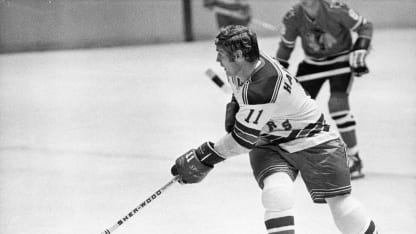
© Barton Silverman
"But then I realized, 'Boy if you hit that puck, it's going.' And lots of times it would go out and it would drop like a curveball."
Hadfield and Hull had known one another for years, having played junior hockey for St. Catharine's, in Ontario, both as members of the Black Hawks organization. They never were teammates - a year before Hadfield arrived, 1958-59, Hull had left for the Black Hawks, with whom he scored 610 regular-season goals, reaching 50 in five different seasons.
"It was one of my old Northlands that I gave him that had a pretty good hook in it," Hull said in an interview with NYRangers.com. "He must've ordered sticks from Northland after that with my hook in it.
"Vic was one of the few that after (Stan) Mikita and I started playing with the hooked stick in '63, he was one of the guys later on - it took him a while to catch onto it, but all of a sudden he knew where the puck was going," Hull continued. "Being as big and strong as he was, he could really whistle the puck. And of course, Jean Ratelle being the great playmaker that he was, as was Rod, they got the puck to Vic as often as they could, so he could blister it."
By the 1967-68 season, Hadfield's seventh in the NHL, he turned in his first 20-goal campaign - that is, his first of nine consecutive 20-plus goal campaigns, including his signature season, 50 goals in 1971-72, when he and Hull tied for second in goals behind Phil Esposito of Boston.
"I start playing with (the curved blades), and as we're going along, one year I had 15 goals, and then I went to 20 goals - and I thought, 'Boy, this is good. I'm going to keep using this,'" Hadfield said. "And then toward the latter part, the early '70s maybe, I started to get away from that because my game had changed where I've got to be able to handle that puck, stickhandle a little bit, control it better. So that's went I went to one with a little less curve, and that's what I ended up using. Big difference from Bobby's curve, but still a curve."
Borrowing Hull's sticks, he said, "got me going and thinking a little bit different. Being aggressive to start, and then as our line progressed, I had to be careful now, I couldn't take any penalties because it was going to jeopardize the team. I was still aggressive, but that wasn't my main role."
"A lot of guys were a little skeptical," Hull said. "Once they got onto it they used it pretty good. Then there were other guys that didn't know where it was going when they shot it - it was either top corner or second balcony.
"Vic, I know, used a pretty good hook after a while, and used it to great advantage. He scored a lot of goals with Rod and Jean."
Not everyone was over the moon that Hadfield had added this tool to his arsenal.
"He developed a really good shot, but we had to curb him at one time or another, because he was copying Bobby with that curved stick," Gilbert said. "He scored a goal against Chicago from the red line - so here we are, we worked hard to get the puck out of our end, and then we finally pass it to him, thinking that he's going to enter with the puck and then make a play. No, he shoots from the red line, and he scores. The puck was going over the glass, but because of the curved stick it had an effect on it and it dropped behind Glenn Hall and he scored.
"'Ooooh, that's great!' So now he thinks he can shoot from there all the time. I said, 'Vic, if you do that one more time, we're not passing you the puck.'"
The question of who first used a curved blade is something of a hot-button issue in hockey lore: Mikita, the Black Hawks Hall of Famer who passed away in August, has laid claim to it, but in New York there is a different version of history.
"The curved stick was discovered, invented by Andy Bathgate," Gilbert said, unequivocally. "I know that because I saw him do it."
The curved blade, of course, has been standard issue for decades now, but it took some effort to master the curve before it became ubiquitous. Although to hear Hadfield tell it, some of its appeal may have been in its wildness.
"Oh, did that puck ever dip and dive," Hadfield said. "I didn't know where it was going, so the bloody goalie sure as hell didn't know."
READ MORE: Vic Hadfield Legendary Moments No. 6: Run to '72 Final


